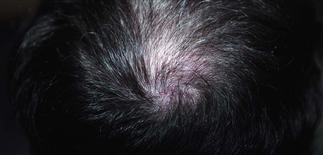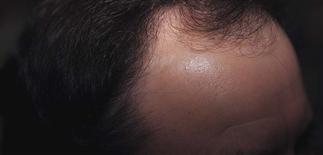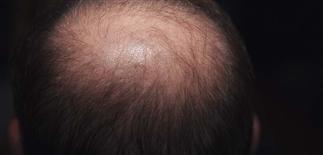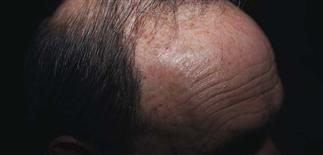149
Androgenic alopecia (male pattern baldness)

Early pattern loss on the vertex.

Early pattern loss with frontal recession.

Extensive loss on the vertex, frontal hair is retained.

Extensive loss on the frontal, vertex and crown areas.
DESCRIPTION
A genetically predetermined, androgen-dependent loss of hair, primarily of the frontal, vertex, and scalp crown but may be total.
HISTORY
• A physiologic occurrence induced by androgens in genetically predisposed men. • Pattern of inheritance is probably polygenic. • Can begin any time after puberty; usually expressed by age 40. • Progression and various patterns of hair loss have been classified by Hamilton. Triangular frontotemporal recession occurs normally in most young men (type 1) and women after puberty. First signs of balding are increased frontotemporal recession accompanied by midfrontal recession (type 2). Hair loss in a round area on the vertex follows, and the density of hair decreases, sometimes rapidly, over top of the scalp (types 3–7).
PHYSICAL FINDINGS
• Terminal hair follicles are transformed into vellus-like follicles. Terminal hair is replaced by fine, light, vellus hair, which is shorter and has a reduced diameter. • With time, further atrophy occurs, leaving scalp shiny and smooth. Follicles disappear. • Begins with bitemporal thinning that progresses to an M-shaped recession. • There is a loss of hair focally in crown of the scalp, which may extend to total hair loss in the central scalp. • There is increased growth of secondary sexual hair (that on chest, in axillae, and in pubic and beard areas).
TREATMENT
• Minoxidil (Rogaine). A topical 2% or 5% solution available over the counter. It is applied to a dry scalp twice a day. Ideal candidates are men under 30 years. Regrowth takes 8–12 months. May help stop further loss but must be used continually to preserve growth. • Finasteride (Propecia) 1 mg. An oral prescription medication taken daily. It works by blocking 5α-reductase in the scalp. No laboratory tests necessary. It must be used daily and chronically to stabilize or reverse balding. Decreased libido and erectile dysfunction occur in less than 2% of men taking finasteride. Contraindicated for women. • Hair transplants. Have been used successfully for years to permanently restore hair. Hair weaves have been refined in a process whereby strands of human hair are applied to a thin nylon filament anchored to the scalp with the patient’s own hair. Another option is surgical: an anteroposterior elliptic excision of bald vertex scalp with primary closure can provide an instant hair effect.







